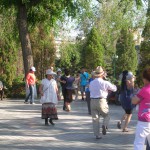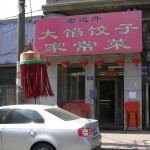We arrived in Beijing 北京on 20 December 2012 as a light snow was falling. Jonghyun and I had enjoyed an early Christmas party in Cambridge where I was able to be Santa for a passel of our friend’s young children. It felt like the holidays as the Beijing flurries continued while we checked in to the Raffles Hotel and then took a walk in the December evening. Christmas Eve was spent being entertained by little girls dressed as snowflakes singing winter songs in Chinese and a chamber orchestra playing Western Christmas carols. We invited our friend Jeff who lives in the city for a holiday buffet at the hotel. We first met him when he arrived in Boston for university in 2000, and he is now a manager at a large international PR firm. We spent Christmas Day visiting the newly re-opened National Museum of China (中國國家博物館), where the galleries are nicely done, but stop before the West arrives in force and the historical interpretations are not so easy to make for Chinese scholars. The Museum’s official analysis of modern history, as seen in the modern history galleries, blames the French and English for their imperialism, but makes little reference to the US, unlike earlier decades in China during the Cultural Revolution of the 1960s when America was vilified.
Jonghyun and I then flew to Changchun 長春 and into the Manchurian winter of Northeast China. Temperatures ranged from highs of -19C to lows of -24C, with light snow in the mornings. After the Japanese occupied the region in 1931, they changed the city name to Hsingking (New Capital 新京), then in 1934 installed the last Qing emperor, the previously deposed Pu Yi 浦儀, as head of their puppet state of Manchukuo (滿洲帝國). I was happy to see that a great many buildings remain from that era and, indeed, many are still in daily use as university or administrative structures. Most have been designated as historic places for preservation. We also visited the palace the Japanese built for Pu Yi (溥儀皇宮) and found it impressive with tasteful interior appointments and a lot of handsome wood paneling, even if on a modest scale for someone of emperor rank.

A village in Manchuria
Professor Qu Xiaofan 曲曉范, who had assisted in the translation of my study of civil government in Manchuria for the Chinese edition that was published earlier in 2012, took me for a private viewing of the rare book collection at Northeast Normal University (東北師範大學) where he teaches. We spent New Years’ Eve with Professor Li Juan 李娟and her young baby, relaxing with her family and home-made food. One day Jonghyun and I took a three hour walk through a part of the city where many of the Japanese-built structures were in use as facilities of Jilin University (吉林大學). It was fun while in the city to sight buildings from the 1920s and 1930s, with their low and solid architectural styles, a contrast to the rising skyscrapers of today.
A week before we arrived a new fast train had just started service to Harbin 哈爾濱, so from our reserved seats we saw the snow-bound white landscape of Manchuria whiz by as we headed farther north. The spacious and gleaming stations of marble for the new service were practically empty, yet fully operational. It was colder in Harbin, with highs of -21C and lows of -27C, except when the wind made it feel like -34C, as the local newspaper reported. Everything was covered with a coat of ice, so both vehicles and pedestrians moved in slow motion, especially at intersections. The famous ice festival sculptures were everywhere, with replicas of buildings and gates and towers, all lit with neon lights from the inside, so at night they turned into fairyland palaces of pink and green and yellow and blue. Ice sculptures were in the nearby park and also in the middle of the pedestrian road near our Modern Hotel (Madieer, the French pronunciation of the word, written as 馬迭爾). This hotel keeps its 1920s ambiance and graces.

Ron and Jonghyun in an ice cave in Harbin
One evening we walked onto the frozen Songhua River 松花江. Out towards the middle, I did not want to continue, because there was a brisk wind sharp as knives, and I had seen the river in the spring, deep and flowing quickly. But then I noticed four-wheel-drive jeeps going back and forth, so was reassured about the thickness of the ice, although we nevertheless turned and headed back to shore.
I am scheduled for a conference on the Russian-built Chinese Eastern Railway (中東鐵路) in Washington, DC in January, so I was interested to see what remained of CER buildings in the city. Many buildings still stand, it turns out, mostly constructed from the late 1800s to about 1906 (the Japanese defeated Russia in the Russo-Japanese War of 1904-1905) and all showing signs of old Moscow with cupolas, arched windows, filigree decorations, and the buildings often painted in a European yellow, soft green or deep pink. The impact of Czarist Russia’s investment in this region is clear to see from the infrastructure they created, of buildings, rail lines, highways, and modern city life. Among the remaining influences from Russia are the markets filled with smoked sausages, blocks of cheese, and fresh-baked breads, all eagerly enjoyed by the Chinese citizens of Harbin, as well as by Ron and Jonghyun.
We ended our trip with a few days in Shanghai 上海 to re-acclimatize to normal winter weather. At the Great Border Guandi Temple (大境關帝廟 , it sits alongside the sliver of Shanghai’s old city wall that still remains), we came upon a Daoist ceremony to carry the soul of the deceased safely over the difficulties of the underworld (超渡亡靈). Given the informal state of Daoist ceremonies, I was able to stand close to the priests as they chanted and also stood behind the chief priest to read the scripture over his shoulder as he recited the lines aloud. This was a treat for me!
In each city I was able to collect research materials at the used book and antique markets. Professor Qu in Changchun showed me the mutual friendships of respect he has developed with the antique book dealers in his city, and I’ve taken it as a guide for my own interactions with these dealers in the future. It is fun to chat with the book sellers, some of whom are retired workers and have little idea of the actual content or even the market value of the hand-written materials they are selling. Sometimes, seeing my interest, they quote me a low price just to encourage this strange foreign guy who seems so eager to learn about China in the past hundred and fifty years—this happened twice during our visit.
We left Shanghai on 9 January 2013 and our room at the historic Astor House Hotel (浦江飯店), whose guests have included President Ulysses S. Grant, Bertrand Russell, Albert Einstein, Edgar Snow, Zhou Enlai, Ron and Jonghyun. The hotel preserves the dark wood and heavy furniture preferred in earlier times.
I learned a lot during this visit, but will close with the most satisfying event. On an earlier visit to Beijing I made a small donation to the Baiyun Daoist Temple (白雲觀) to allow them to print books for free distribution at the temple. The donor gains merit – good karma –and the public may take away any of the books available. On this visit I found one of the free books where my name was listed! It was an essay supposedly by the master philosopher Lao Tse (Laozi老子) on actions and responses in Daoism (太上感應篇 ). Across all of the miles, I have become a member of the temple community.





